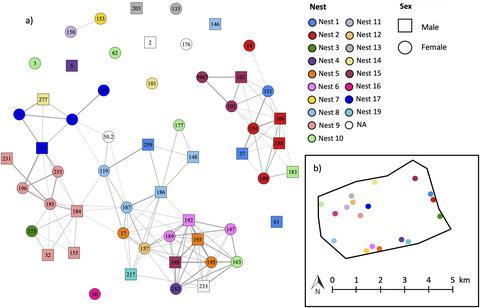当前位置:
X-MOL 学术
›
Austral Ecol.
›
论文详情
Our official English website, www.x-mol.net, welcomes your
feedback! (Note: you will need to create a separate account there.)
Understanding dispersal patterns can inform future translocation strategies: A case study of the threatened greater stick-nest rat (Leporillus conditor)
Austral Ecology ( IF 1.6 ) Pub Date : 2021-08-13 , DOI: 10.1111/aec.13100 Isabelle R. Onley 1 , Jeremy J. Austin 1 , Kieren J. Mitchell 1, 2 , Katherine E. Moseby 3
Austral Ecology ( IF 1.6 ) Pub Date : 2021-08-13 , DOI: 10.1111/aec.13100 Isabelle R. Onley 1 , Jeremy J. Austin 1 , Kieren J. Mitchell 1, 2 , Katherine E. Moseby 3
Affiliation

|
Dispersal behaviour and sociality are significant factors influencing survival at both the individual and population levels. In translocation and breeding programmes, social structure and sex-biased philopatry and dispersal should be considered in order to maximise population viability and conservation outcomes. Here, we use the greater stick-nest rat (Leporillus conditor), a native Australian rodent, as a case study to understand how knowledge of social structure and dispersal can inform conservation and translocation programmes. We combine high-throughput DNA sequencing with field trapping data from a translocated population of greater stick-nest rats at Arid Recovery Reserve, South Australia, to provide the first empirical evidence of female philopatry and male-biased dispersal in this species. Males were found to disperse, on average, 1.5 km from the natal nest, while females typically did not disperse beyond 500 m. Further, recapture data showed that females demonstrated a higher degree of nest fidelity than males over time. Based on these findings, we make two key recommendations for future translocations of the species. Firstly, founders should be harvested in small groups at adjacent nest sites with groups separated by a minimum of 1.5 km allowing family group structure to be retained during translocation while simultaneously maximising genetic diversity. Secondly, translocated individuals should be released in family cohorts into patches of optimal habitat that contain adequate shelter substrates interspersed over short distances (~300–500 m, the maximum dispersal distance of females found in this study), thereby facilitating nest establishment and maintenance of family groups. The results of this study have implications for conservation and reintroduction biology as a whole; we highlight the importance of considering spatial genetic structure during all stages of translocations to improve outcomes, and the value of combining genetic and field data to better understand species’ social and spatial preferences.
中文翻译:

了解扩散模式可以为未来的易位策略提供信息:受威胁的大粘巢鼠(Leporillus conditor)的案例研究
分散行为和社会性是影响个人和人口水平生存的重要因素。在易地和育种计划中,应考虑社会结构和有性别偏见的育种和传播,以最大限度地提高种群生存能力和保护结果。在这里,我们使用更大的粘巢鼠(Leporillus conditor),一种澳大利亚本土啮齿动物,作为案例研究,了解社会结构和传播知识如何为保护和易地计划提供信息。我们将高通量 DNA 测序与来自南澳大利亚干旱恢复保护区的大型棒巢大鼠易位种群的野外诱捕数据相结合,以提供该物种中雌性嗜血和雄性偏向散布的第一个经验证据。雄性被发现平均分散在距出生巢 1.5 公里的地方,而雌性通常不会分散到 500 米以外。此外,重新捕获数据显示,随着时间的推移,雌性比雄性表现出更高程度的巢忠诚度。基于这些发现,我们对该物种的未来易位提出了两个关键建议。第一,创始人应该在相邻的巢址以小组的形式收获,这些群体之间的距离至少为 1.5 公里,以便在易位期间保留家庭群体结构,同时最大限度地提高遗传多样性。其次,易位个体应该在家庭群体中被释放到最佳栖息地的斑块中,这些栖息地包含散布在短距离(~300-500 m,本研究中发现的雌性的最大分散距离)的足够庇护基质,从而促进巢穴的建立和维护。家庭团体。这项研究的结果对整个保护和重新引入生物学有影响;我们强调在易位的所有阶段考虑空间遗传结构以改善结果的重要性,
更新日期:2021-08-13
中文翻译:

了解扩散模式可以为未来的易位策略提供信息:受威胁的大粘巢鼠(Leporillus conditor)的案例研究
分散行为和社会性是影响个人和人口水平生存的重要因素。在易地和育种计划中,应考虑社会结构和有性别偏见的育种和传播,以最大限度地提高种群生存能力和保护结果。在这里,我们使用更大的粘巢鼠(Leporillus conditor),一种澳大利亚本土啮齿动物,作为案例研究,了解社会结构和传播知识如何为保护和易地计划提供信息。我们将高通量 DNA 测序与来自南澳大利亚干旱恢复保护区的大型棒巢大鼠易位种群的野外诱捕数据相结合,以提供该物种中雌性嗜血和雄性偏向散布的第一个经验证据。雄性被发现平均分散在距出生巢 1.5 公里的地方,而雌性通常不会分散到 500 米以外。此外,重新捕获数据显示,随着时间的推移,雌性比雄性表现出更高程度的巢忠诚度。基于这些发现,我们对该物种的未来易位提出了两个关键建议。第一,创始人应该在相邻的巢址以小组的形式收获,这些群体之间的距离至少为 1.5 公里,以便在易位期间保留家庭群体结构,同时最大限度地提高遗传多样性。其次,易位个体应该在家庭群体中被释放到最佳栖息地的斑块中,这些栖息地包含散布在短距离(~300-500 m,本研究中发现的雌性的最大分散距离)的足够庇护基质,从而促进巢穴的建立和维护。家庭团体。这项研究的结果对整个保护和重新引入生物学有影响;我们强调在易位的所有阶段考虑空间遗传结构以改善结果的重要性,







































 京公网安备 11010802027423号
京公网安备 11010802027423号